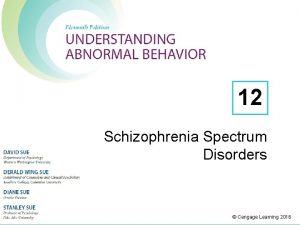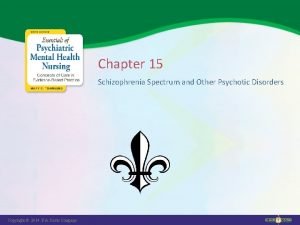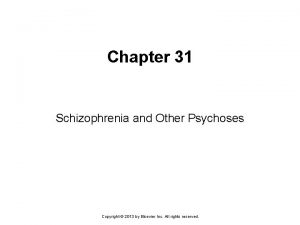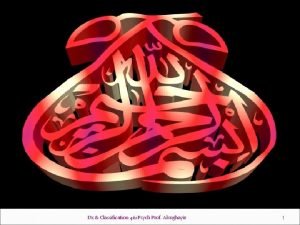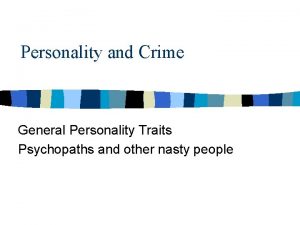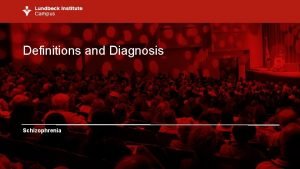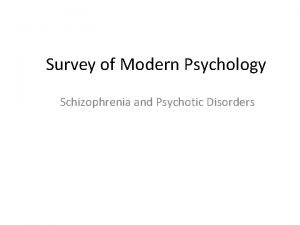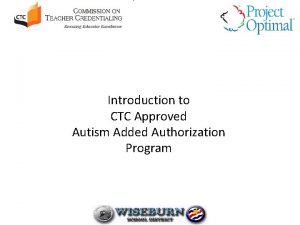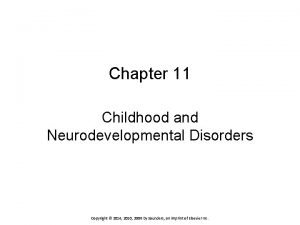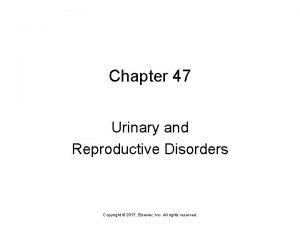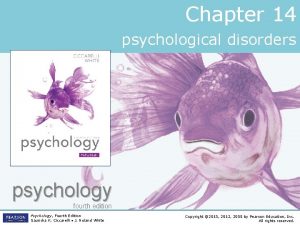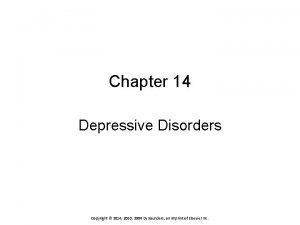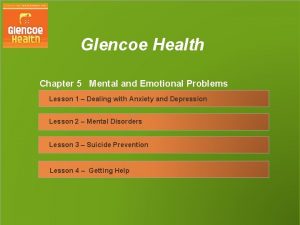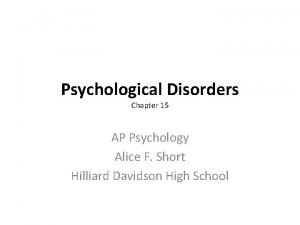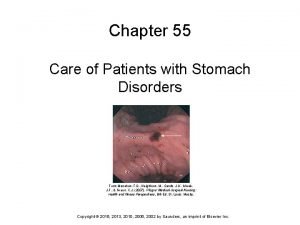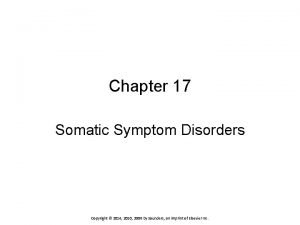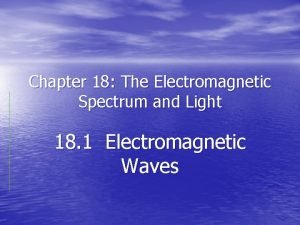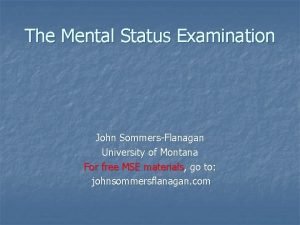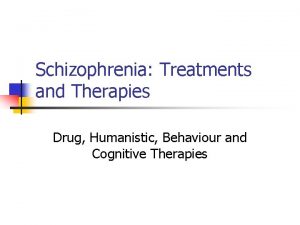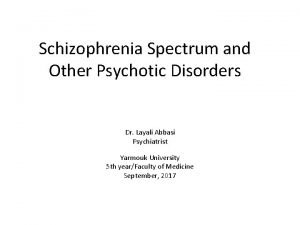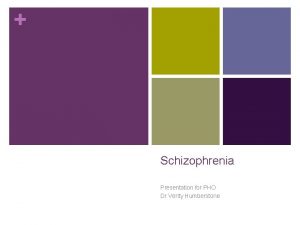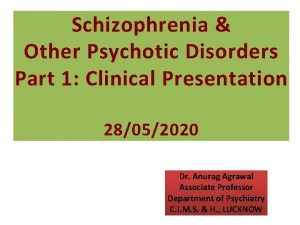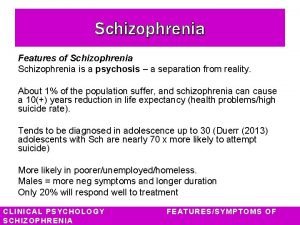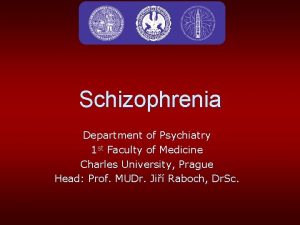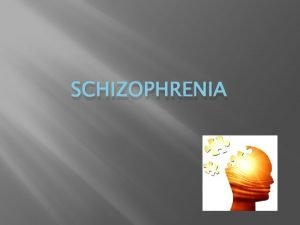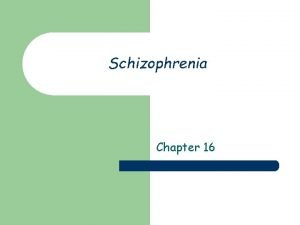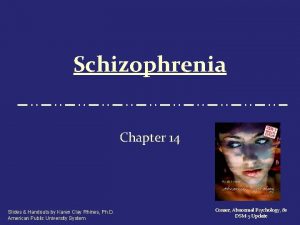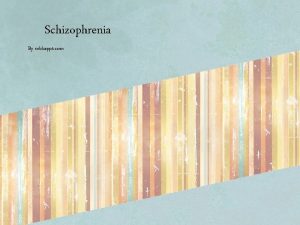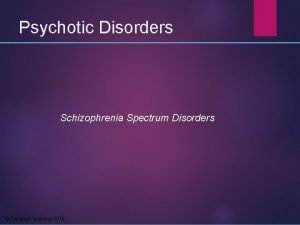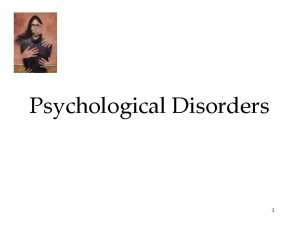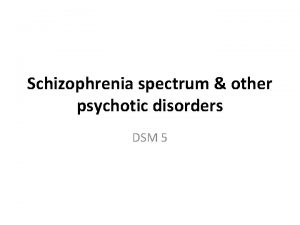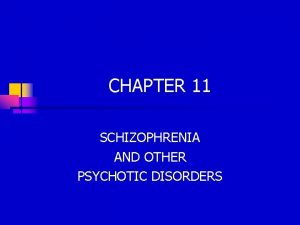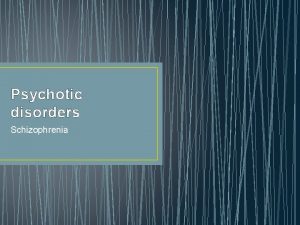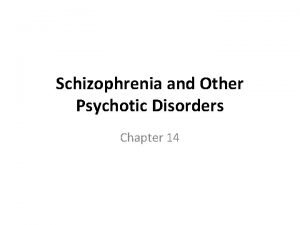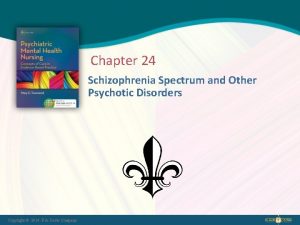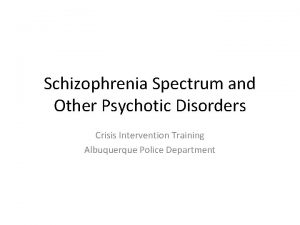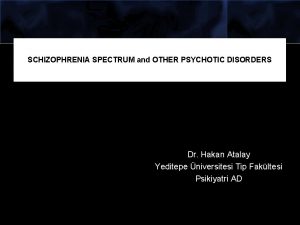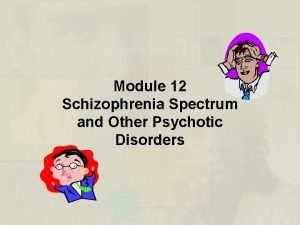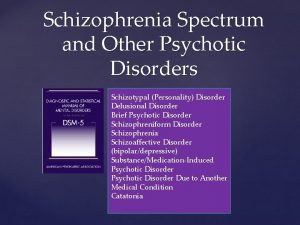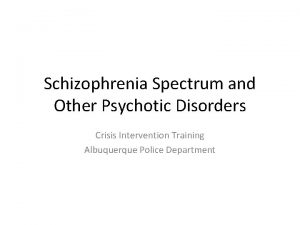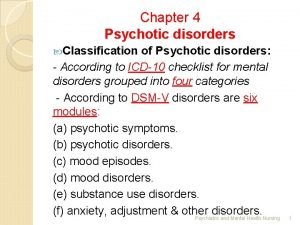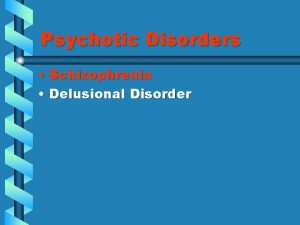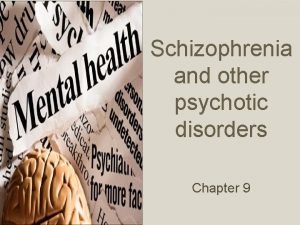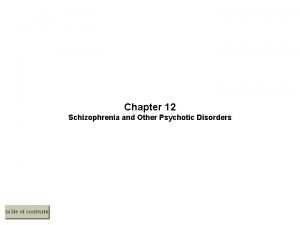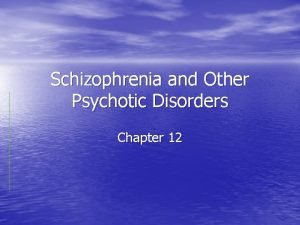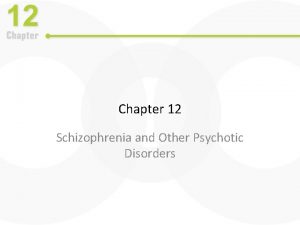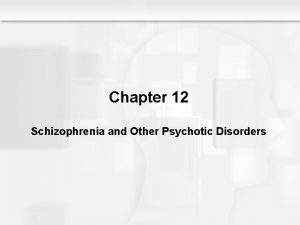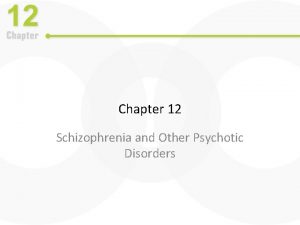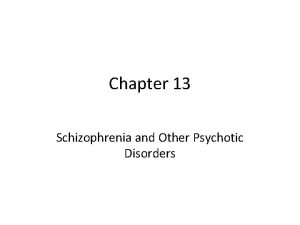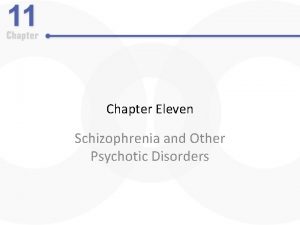Chapter 13 Schizophrenia Spectrum and Other Psychotic Disorders










































![[INSERT photo, p. 492 HERE] [INSERT photo, p. 492 HERE]](https://slidetodoc.com/presentation_image_h2/1c3aa9a85a1b06aa1b876d464eb9ed6e/image-43.jpg)

















![[INSERT Table 13. 3 HERE, p. 503] [INSERT Table 13. 3 HERE, p. 503]](https://slidetodoc.com/presentation_image_h2/1c3aa9a85a1b06aa1b876d464eb9ed6e/image-61.jpg)
![Treatment of Schizophrenia : Psychosocial Interventions [INSERT Table 13. 3 HERE, p. 503] Treatment of Schizophrenia : Psychosocial Interventions [INSERT Table 13. 3 HERE, p. 503]](https://slidetodoc.com/presentation_image_h2/1c3aa9a85a1b06aa1b876d464eb9ed6e/image-62.jpg)

- Slides: 63

Chapter 13 Schizophrenia Spectrum and Other Psychotic Disorders

Outline Introduction to Schizophrenia Spectrum Disorders Symptoms of Schizophrenia Prevalence and Causes of Schizophrenia Treatment of Schizophrenia

Focus Questions How is schizophrenia defined? What are the clinical features of schizophrenia and related disorders? What are positive, negative and disorganized symptoms? What factors contribute to the development of schizophrenia? What treatments exist for schizophrenia?

Key Terms Psychosis: gross departure from reality, which may include: § Hallucinations: Sensory experiences in the absence of sensory input (e. g. hearing voices) § Delusions: Strong, inaccurate beliefs that persist in the face of evidence to the contrary Schizophrenia: A pervasive type of psychosis characterized by disturbed thought, emotion, behavior

Nature of Schizophrenia and Psychosis: History and Current Thinking Historical background § Emil Kraepelin – used the term dementia praecox to describe schizophrenic syndrome Early subtypes of schizophrenia – Catatonia, hebephrenia and paranoia § Eugen Bleuler – introduced the term “schizophrenia” “Splitting of the mind”

Nature of Schizophrenia and Psychosis: History and Current Thinking [INSERT Table 13. 1 HERE, p. 478]

Nature of Schizophrenia and Psychosis: History and Current Thinking Impact of early ideas on current thinking § Many of Kraeplin and Bleuler’s ideas are still with us § Understanding onset and course considered important Psychotic behavior § May refer only to hallucinations or delusions or to the unusual behavior (e. g. inappropriate emotionality, strange actions) accompanying them


Symptoms of Schizophrenia “Positive” symptoms: § Active manifestations of abnormal behavior § Distortions or exaggerations of normal behavior “Negative” symptoms: § Absence of normal behavior “Disorganized” symptoms: § Erratic speech, emotions and behavior

Schizophrenia: The “Positive” Symptom Cluster Include delusions and hallucinations Delusions: “The basic feature of madness” § Gross misrepresentations of reality § Most common: Delusions of grandeur Delusions of persecution

Schizophrenia: The “Positive” Symptom Cluster Hallucinations § Experience of sensory events without environmental input § Can involve all senses (e. g. , tasting something when not eating, having skin sensations when not being touched) § Most common: Auditory

Schizophrenia: The “Positive” Symptom Cluster Findings from SPECT studies § Neuroimaging shows that the part of the brain most active during auditory hallucinations is Broca’s area Involved in speech production (not comprehension)


Schizophrenia: The “Negative” Symptom Cluster Absence or insufficiency of normal behavior Spectrum of negative symptoms § Avolition (or apathy) – lack of initiation and persistence § Alogia – relative absence of speech § Anhedonia – lack of pleasure, or indifference § Affective flattening – little expressed emotion

Schizophrenia: The “Disorganized” Symptom Cluster Confused or abnormal speech, behavior, and emotion Nature of disorganized speech § Cognitive slippage – illogical and incoherent speech § Tangentiality – “going off on a tangent” § Loose associations – conversation in unrelated directions

Schizophrenia: The “Disorganized” Symptom Cluster Nature of disorganized affect § Inappropriate emotional behavior Nature of disorganized behavior § Includes a variety of unusual behaviors § Catatonia May be considered a psychotic spectrum disorder in its own right or, when occurring in the presence of schizophrenia, a symptom of schizophrenia

Subtypes of Schizophrenia: A Thing of the Past Schizophrenia was previously divided in to subtypes based on content of psychosis This is no longer the case in DSM-5, but outdated terms are still in partial use Included paranoid, catatonic, residual (minor symptoms persist after past episode), disorganized (many disorganized symptoms) and undifferentiated

Other Psychotic Disorders: Schizophreniform Disorders Schizophreniform disorder § Psychotic symptoms lasting between 1 -6 months (>6 months = schizophrenia) § Associated with relatively good functioning § Most patients resume normal lives § Lifetime prevalence: approximately 0. 2%


Other Psychotic Disorders: Schizoaffective Disorder Schizoaffective disorder § Symptoms of schizophrenia + additional experience of a major mood episode (depressive or manic) § Psychotic symptoms must also occur outside the mood disturbance § Prognosis is similar for people with schizophrenia § Such persons do not tend to get better on their own


Other Psychotic Disorders: Delusional Disorder Key feature: Delusions that are contrary to reality § Lack other positive and negative symptoms § Types of delusions include Erotomanic Grandiose Jealous Persecutory Somatic § Better prognosis than schizophrenia

Other Psychotic Disorders: Delusional Disorder Very rare; affects 26 -60 individuals per 100, 000 Later age of onset, between ages 35 – 55 Somewhat more common in females § 55% of patients with this disorder are female


Catatonia Unusual motor responses, particularly immobility or agitation, and odd mannerisms Tends to be severe and quite rare May be present in psychotic disorders or diagnosed alone, and may include: Stupor, mutism, maintaining the same pose for hours § Opposition or lack of response to instructions § Repetitive, meaningless motor behaviors § Mimicking others’ speech or movement


Psychotic Disorders Due to Other Causes Psychosis may occur as the result of substance use, some medications and some medical conditions Knowing these causes is important for treatment § Address underlying cause Include: § Substance/medication-induced psychotic disorder § Psychotic disorder associated with another medical condition



Brief Psychotic Disorder Positive symptoms of schizophrenia (e. g. , hallucinations or delusions) or disorganized symptoms Lasts less than 1 month Briefest duration of all psychotic disorders Typically precipitated by trauma or stress


Attenuated Psychosis Syndrome Identified as a condition in need of further study in DSM-5 Refers to individuals who are at high risk for developing schizophrenia or beginning to show signs of schizophrenia Label designed to focus attention on these individuals who could benefit from early intervention Tend to have good insight into own symptoms

Schizophrenia: Statistics Onset and prevalence of schizophrenia worldwide § About 0. 2% to 1. 5% (or about 1% population) § Often develops in early adulthood § Can emerge at any time; childhood cases are extremely rare but not unheard of

Schizophrenia: Statistics Schizophrenia is generally chronic § Most suffer with moderate-to-severe lifetime impairment § Life expectancy is slightly less than average Increased risk for suicide Increased risk for accidents Self care may be poorer

Schizophrenia: Statistics Schizophrenia affects males and females about equally § Females tend to have a better long-term prognosis § Onset slightly earlier for males Cultural factors § Psychotic behaviors not always pathologized § Yet schizophrenia is found at similar rates in all cultures

Course of Schizophrenia Prodromal phase § 85% experience § 1 -2 years before serious symptoms § Less severe, yet unusual symptoms: Ideas of reference Magical thinking Illusions Isolation Marked impairment in functioning Lack of initiative, interests, or energy

Course of Schizophrenia

Causes of Schizophrenia: Findings From Genetic Research Family studies § Inherit a tendency for schizophrenia, not specific forms of schizophrenia § Risk increases with genetic relatedness E. g. , having a twin with schizophrenia incurs greater risk than having an uncle with schizophrenia


Causes of Schizophrenia: Findings From Genetic Research Twin studies § Monozygotic twins vs fraternal (dizygotic) twins At greater risk if your identical twin has schizophrenia Supports role of genes

Causes of Schizophrenia: Findings From Genetic Research Adoption studies § Adoptee risk for developing schizophrenia remains high if a biological parent has schizophrenia § But risk is lower than for children raised by their biological parent with schizophrenia – healthy environment is a protective factor

![INSERT photo p 492 HERE [INSERT photo, p. 492 HERE]](https://slidetodoc.com/presentation_image_h2/1c3aa9a85a1b06aa1b876d464eb9ed6e/image-43.jpg)
[INSERT photo, p. 492 HERE]

Search for Genetic and Behavioral Markers of Schizophrenia Genetic markers: Linkage and association studies § Endophenotypes § Schizophrenia is likely to involve multiple genes Behavioral marker (endophenotype): Smoothpursuit eye movement § Schizophrenia patients show reduced ability to track a moving object with their eyes § Relatives of schizophrenic patients also have deficits in this area


Causes of Schizophrenia: Neurobiological Influences The dopamine hypothesis: schizophrenia is partially caused by overactive dopamine Evidence § Drugs that increase dopamine (agonists) result in schizophrenic-like behavior § Drugs that decrease dopamine (antagonists) reduce schizophrenic-like behavior Examples – neuroleptics, L-Dopa for Parkinson’s disease Problem: overly simplistic § Many neurotransmitters are likely involved


Causes of Schizophrenia: Other Neurobiological Influences Structural and functional abnormalities in the brain § Enlarged ventricles and reduced tissue volume § Hypofrontality – less active frontal lobes A major dopamine pathway Viral infections during early prenatal development § Findings are inconclusive


Other Neurobiological Influences Marijuana use also increases the risk for developing schizophrenia in at-risk individuals Conclusions about neurobiology and schizophrenia § Schizophrenia reflects diffuse neurobiological dysregulation § Structural and functional brain abnormalities Not unique to schizophrenia

Causes of Schizophrenia: Psychological and Social Influences The role of stress § May activate underlying vulnerability § May also increase risk of relapse Family interactions § Unsupported theories Schizophrenogenic mother Double bind communication § High expressed emotion (EE)– associated with relapse


Causes of Schizophrenia: Psychological and Social Influences The role of psychological factors § May function as the diathesis in a diathesisstress model § Exert only a minimal effect in producing schizophrenia

Medical Treatment of Schizophrenia Historical precursors were generally ineffective and often barbaric Development of antipsychotic (neuroleptic) medications § Often the first line treatment for schizophrenia § Began in the 1950 s § Most reduce or eliminate positive symptoms § Primarily affect dopamine system, but also affect serotonergic and glutamate system

Medical Treatment of Schizophrenia Acute and permanent side effects are common with first-generation medications § Parkinson’s-like side effects § Tardive dyskinesia § Compliance with medication is often a problem Aversion to side effects Financial cost Poor relationship with doctors


Psychosocial Treatment of Schizophrenia Historical precursors: Psychodynamic therapy was not effective Psychosocial approaches § Behavioral (i. e. , token economies) on inpatient units: reward adaptive behavior § Community care programs § Social and living skills training § Behavioral family therapy § Vocational rehabilitation

Psychosocial Treatment of Schizophrenia Illness management and recovery § Engages patient as an active participant in care § Continuous goal setting and tracking § Modules include: social skills training, stress management, substance use

Psychosocial Treatment of Schizophrenia Cultural considerations § Take into account cultural factors that influence individuals’ understanding of their own illness (e. g. , supernatural beliefs) § Involve family and community if possible

Psychosocial Treatment of Schizophrenia Prevention § Identify at-risk children Relatives of individuals with schizophrenia § Foster supportive, stable environments § Offer additional treatment at prodromal stages, including social skills training
![INSERT Table 13 3 HERE p 503 [INSERT Table 13. 3 HERE, p. 503]](https://slidetodoc.com/presentation_image_h2/1c3aa9a85a1b06aa1b876d464eb9ed6e/image-61.jpg)
[INSERT Table 13. 3 HERE, p. 503]
![Treatment of Schizophrenia Psychosocial Interventions INSERT Table 13 3 HERE p 503 Treatment of Schizophrenia : Psychosocial Interventions [INSERT Table 13. 3 HERE, p. 503]](https://slidetodoc.com/presentation_image_h2/1c3aa9a85a1b06aa1b876d464eb9ed6e/image-62.jpg)
Treatment of Schizophrenia : Psychosocial Interventions [INSERT Table 13. 3 HERE, p. 503]

Summary of Schizophrenia and Psychotic Disorders Psychotic disorders: Break from reality resulting in a spectrum of dysfunctions § Affecting cognitive, emotional, and behavioral domains § Schizophrenia involves positive, negative, and disorganized symptom clusters § Medication is somewhat effective for positive symptoms, but much room for improvement in treatment
 Chapter 12 schizophrenia spectrum disorders
Chapter 12 schizophrenia spectrum disorders Chapter 12 schizophrenia spectrum disorders
Chapter 12 schizophrenia spectrum disorders Anticholinergic rhyme
Anticholinergic rhyme Chapter 31 schizophrenia and other psychoses
Chapter 31 schizophrenia and other psychoses Neurosis vs psychosis
Neurosis vs psychosis Puberty and autism spectrum disorders
Puberty and autism spectrum disorders Qualities of a psychopath
Qualities of a psychopath Schizophreniform disorder icd-10
Schizophreniform disorder icd-10 Types of delusions
Types of delusions Autism spectrum disorder authorization california
Autism spectrum disorder authorization california Chromium and copper electron configuration
Chromium and copper electron configuration Bipolar and other related disorders
Bipolar and other related disorders Bipolar and other related disorders
Bipolar and other related disorders Absorption spectrum
Absorption spectrum Define a primary skin lesion and list three types
Define a primary skin lesion and list three types Chapter 6 musculoskeletal system
Chapter 6 musculoskeletal system Chapter 46 digestive and endocrine disorders
Chapter 46 digestive and endocrine disorders Chapter 29 somatic symptom and dissociative disorders
Chapter 29 somatic symptom and dissociative disorders Chapter 29 endocrine and metabolic disorders
Chapter 29 endocrine and metabolic disorders Chapter 21 mental health diseases and disorders
Chapter 21 mental health diseases and disorders Chapter 18 eating and feeding disorders
Chapter 18 eating and feeding disorders Chapter 17 reproductive system diseases and disorders
Chapter 17 reproductive system diseases and disorders Chapter 15 nervous system diseases and disorders
Chapter 15 nervous system diseases and disorders Chapter 15 anxiety and obsessive-compulsive disorders
Chapter 15 anxiety and obsessive-compulsive disorders Chapter 11 childhood and neurodevelopmental disorders
Chapter 11 childhood and neurodevelopmental disorders Elsevier
Elsevier 10 nail diseases and disorders
10 nail diseases and disorders Milady chapter 10
Milady chapter 10 Cardiovascular system diseases and disorders chapter 8
Cardiovascular system diseases and disorders chapter 8 Milady chapter 8 skin disorders and diseases
Milady chapter 8 skin disorders and diseases Chapter 47 urinary and reproductive disorders
Chapter 47 urinary and reproductive disorders Managing weight and eating behaviors
Managing weight and eating behaviors Chapter 10 lymphatic system diseases and disorders
Chapter 10 lymphatic system diseases and disorders Self initiated other repair examples
Self initiated other repair examples Chapter 18 psychological disorders
Chapter 18 psychological disorders Chapter 11 genetic disorders concept mapping
Chapter 11 genetic disorders concept mapping Chapter 18 psychological disorders
Chapter 18 psychological disorders Chapter 14 psychological disorders
Chapter 14 psychological disorders Chapter 14 depressive disorders
Chapter 14 depressive disorders Chapter 5 glencoe health answers
Chapter 5 glencoe health answers Unit 2 mental and emotional health
Unit 2 mental and emotional health Chapter 14 psychological disorders
Chapter 14 psychological disorders Ap psychology chapter 15 psychological disorders
Ap psychology chapter 15 psychological disorders Chapter 55 care of patients with stomach disorders
Chapter 55 care of patients with stomach disorders Chapter 17 somatic symptom disorders
Chapter 17 somatic symptom disorders Chapter 18 electromagnetic spectrum and light
Chapter 18 electromagnetic spectrum and light Psychomotor activity in mse
Psychomotor activity in mse Schizophrenia warning signs
Schizophrenia warning signs Humanistic approach to schizophrenia
Humanistic approach to schizophrenia Schizoaffective disorder
Schizoaffective disorder Akathisea
Akathisea Hebephrenic schizophrenia.
Hebephrenic schizophrenia. Schizophrenia literal translation means
Schizophrenia literal translation means Types of schizophrenia
Types of schizophrenia Thesis statement on schizophrenia
Thesis statement on schizophrenia Types of schizophrenia
Types of schizophrenia Hebephrenic schizophrenia
Hebephrenic schizophrenia Schizophrenia def
Schizophrenia def Schizophrenia disorganized behavior
Schizophrenia disorganized behavior Example of loose associations in schizophrenia
Example of loose associations in schizophrenia Thought insertion
Thought insertion Phases of schizophrenia
Phases of schizophrenia Double bind
Double bind Negative explanatory style
Negative explanatory style

